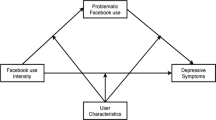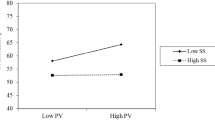Abstract
Although studies have shown that depressive symptoms, life satisfaction, and adolescents’ online peer victimization are associated, there remain critical gaps in our understanding of these relationships. To address these gaps, the present two-wave panel study (N Time1 = 1840) (1) examines the short-term longitudinal and reciprocal relationships between peer victimization on Facebook, depressive symptoms and life satisfaction during adolescence, and (2) explores the moderating role of adolescents’ gender, age, and perceived friend support. Self-report data from 1621 adolescent Facebook users (48 % girls; M Age = 14.76; SD = 1.41) were used to test our hypotheses. The majority of the sample (92 %) was born in Belgium. Cross-lagged analyses indicated that peer victimization on Facebook marginally predicted decreases in life satisfaction, and life satisfaction predicted decreases in peer victimization on Facebook. However, depressive symptoms were a risk factor for peer victimization on Facebook, rather than an outcome. In addition, support from friends protected adolescents from the harmful outcomes of peer victimization on Facebook. Both theoretical and practical implications are discussed.
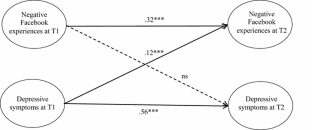
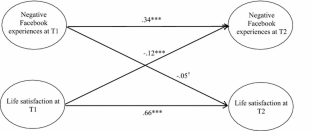

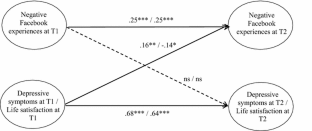
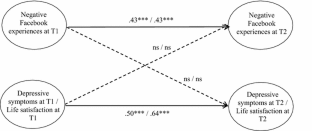
Similar content being viewed by others
References
Angold, A., Erkanli, A., Silberg, J., Eaves, L., & Costello, E. J. (2002). Depression scale scores in 8–17-year-olds: Effects of age and gender. Journal of Child Psychology and Psychiatry, 8, 1052–1063. doi:10.1111/1469-7610.00232.
Auerbach, R. P., Bigda-Peyton, J. S., Eberhart, N. K., Webb, C. A., & Ho, M.-H. R. (2011). Conceptualizing the prospective relationship between social support, stress, and depressive symptoms among adolescents. Journal of Abnormal Child Psychology, 39, 475–487. doi:10.1007/s10802-010-9479-x.
Bandalos, D. L. (2002). The effects of item parceling on goodness-of-fit and parameter estimate bias in structural equation modeling. Structural Equation Modeling: A Multidisciplinary Journal, 9, 78–102. doi:10.1207/S15328007SEM0901_5.
Bandalos, D. L., & Finney, S. J. (2001). Item parceling issues in structural equation modeling. In G. A. Marcoulides & R. E. Schumacker (Eds.), Advanced structural equation modeling: New developments and techniques (pp. 269–296). Mahwah, NJ: Lawrence Erlbaum Associates Inc.
Baumeister, R. F., & Leary, M. R. (1995). The need to belong: Desire for interpersonal attachments as a fundamental human motivation. Psychological Bulletin, 117, 497–529. doi:10.1037/0033-2909.117.3.497.
Bisegger, C., Cloetta, B., von Rueden, U., Abel, T., & Ravens-Sieberer, U. (2005). Health-related quality of life: Gender differences in childhood and adolescence. Sozial- Und Präventivmedizin, 50, 281–291. doi:10.1007/s00038-005-4094-2.
Bonanno, R. A., & Hymel, S. (2013). Cyber bullying and internalizing difficulties: Above and beyond the impact of traditional forms of bullying. Journal of Youth and Adolescence, 42, 685–697. doi:10.1007/s10964-013-9937-1.
Brown, B. B., & Larson, J. (2009). Peer relationships in adolescence. In R. M. Lerner & L. Steinberg (Eds.), Handbook of adolescent psychology (Vol. 1, pp. 74–103). New York, NY: Wiley.
Buhrmester, D., & Prager, K. (1995). Patterns and functions of self-disclosure during childhood and adolescence. In K. J. Rotenberg (Ed.), Disclosure processes in children and adolescents (pp. 57–77). New York, NY: Cambridge University Press.
Cobb, S. (1976). Social support as a moderator of life stress. Psychomatic Medicine, 38, 300–314.
Cohen, S., & Wills, T. A. (1985). Stress, social support, and the buffering hypothesis. Psychological Bulletin, 98, 310–357.
Cole, D. A., & Maxwell, S. E. (2003). Testing mediational models with longitudinal data: Questions and tips in the use of structural equation modeling. Journal of Abnormal Psychology, 112, 558–577. doi:10.1037/0021-843X.112.4.558.
Compian, L. J., Gowen, L. K., & Hayward, C. (2009). The interactive effects of puberty and peer victimization on weight concerns and depression symptoms among early adolescent girls. The Journal of Early Adolescence, 29, 357–375. doi:10.1177/0272431608323656.
Copeland, W. E., Shanahan, L., Costello, J. E., & Angold, A. (2010). Which childhood and adolescent psychiatric disorders predict which young adult disorders? Archives of General Psychiatry, 66, 764–772. doi:10.1001/archgenpsychiatry.2009.85.Which.
Crawford, A. M., & Manassis, K. (2011). Anxiety, social skills, friendship quality, and peer victimization: An integrated model. Journal of Anxiety Disorders, 25, 924–931. doi:10.1016/j.janxdis.2011.05.005.
Crick, N. R., & Bigbee, M. A. (1998). Relational and overt forms of peer victimization: A multiinformant approach. Journal of Consulting and Clinical Psychology, 66, 337–347. doi:10.1037/0022-006X.66.2.337.
Crick, N. R., Nelson, D. A., Morales, J. R., Cullerton-Sen, C., Casas, J. F., & Hickman, S. E. (2001). Relational victimization in childhood and adolescence: I hurt you through the grapevine. In J. Juvonen & S. Graham (Eds.), Peer harassment in school: The plight of the vulnerable and victimized (pp. 1196–1214). New York, NY: The Guilford Press.
De Graaf, R., Bijl, R. V., Smit, F., Ravelli, A., & Vollebergh, W. A. M. (2000). Psychiatric and sociodemographic predictors of attrition in a longitudinal study. American Journal of Epidemiology, 152, 1039–1047. doi:10.1093/aje/152.11.1039.
Dempsey, A. G., Sulkowski, M., Nichols, R., & Storch, E. A. (2009). Differences between peer victimization in cyber and physical settings and associated psychosocial adjustment in early adolescence. Psychology in the Schools, 46, 962–972. doi:10.1002/pits.20437.
Desjardins, T. L., & Leadbeater, B. J. (2011). Relational victimization and depressive symptoms in adolescence: Moderating effects of mother, father, and peer emotional support. Journal of Youth and Adolescence, 40, 531–544. doi:10.1007/s10964-010-9562-1.
Diener, E., Emmons, R., Larsen, J., & Griffin, S. (1985). The satisfaction with life scale. Journal of Personality Assessmemt, 49, 71–75.
Dredge, R., Gleeson, J., & de la Piedad Garcia, X. (2014). Presentation on Facebook and risk of cyberbullying victimisation. Computers in Human Behavior, 40, 16–22. doi:10.1016/j.chb.2014.07.035.
Flemish Department of Education. (2015). Statistisch Jaarboek van het Vlaams Onderwijs, Schooljaar 2013–2014 [Statistical yearbook of Flemish education, academic year 2013–2014]. Brussels: Flemish Deparment of Education.
Gámez-Guadix, M., Orue, I., Smith, P. K., & Calvete, E. (2013). Longitudinal and reciprocal relations of cyberbullying with depression, substance use, and problematic internet use among adolescents. Journal of Adolescent Health, 53, 446–452. doi:10.1016/j.jadohealth.2013.03.030.
Ge, X., Conger, R. D., & Elder, G. H, Jr. (1996). Coming of age too early: Pubertal influences on girls’ vulnerability to psychological distress. Child Development, 67, 3386–3400. doi:10.1111/j.1467-8624.1996.tb01919.x.
Ge, X., Conger, R. D., & Elder, G. H, Jr. (2001). The relation between puberty and psychological distress in adolescent boys. Journal of Research on Adolescence, 11, 49–70. doi:10.1111/1532-7795.00003.
Ge, X., Natsuaki, M. N., & Conger, R. D. (2006). Trajectories of depressive symptoms and stressful life events among male and female adolescents in divorced and nondivorced families. Development and Psychopathology, 18, 253–273. doi:10.1017/S0954579406060147.
Goldbeck, L., Schmitz, T. G., Besier, T., Herschbach, P., & Henrich, G. (2007). Life satisfaction decreases during adolescence. Quality of Life Research, 16, 969–979. doi:10.1007/s11136-011-0096-0.
Green, S. B., Salkind, N. J., & Akey, T. M. (2000). Using SPSS for windows: Analyzing and understanding data. Englewood Cliffs, NJ: Prentice Hall.
Hammen, C. (2006). Stress generation in depression: Reflections on origins, research, and future directions. Journal of Clinical Psychology, 62, 1062–1082. doi:10.1002/jclp.20293.
Hawker, D. S., & Boulton, M. J. (2000). Twenty years’ research on peer victimization and psychosocial maladjustment: A meta-analytic review of cross-sectional studies. Journal of Child Psychology and Psychiatry, 41, 441–455. doi:10.1111/1469-7610.00629.
Hay, I., & Ashman, A. F. (2003). The development of adolescents’ emotional stability and general self-concept: The interplay of parents, peers, and gender. International Journal of Disability, Development and Education, 50, 77–91. doi:10.1080/1034912032000053359.
Hemphill, S. A., Kotevski, A., & Heerde, J. A. (2015). Longitudinal associations between cyber-bullying perpetration and victimization and problem behavior and mental health problems in young Australians. International Journal of Public Health, 60, 227–237. doi:10.1007/s00038-014-0644-9.
Irwin, M., Haydari, K., & Oxman, M. (2012). Screening for depression in the older adult. Archives of International Medicine, 159, 10–13. doi:10.1001/archinte.159.15.1701.
Karatzias, A., Chouliara, Z., Power, K., & Swanson, V. (2006). Predicting general well-being from self-esteem and affectivity: An exploratory study with Scottish adolescents. Quality of Life Research, 15, 1143–1151. doi:10.1007/s11136-006-0064-2.
Kline, R. B. (2011). Principles and pratice of structural equation modeling (Vol. 33). New York, NY: The Guilford Press.
Kochel, K. P., Ladd, G. W., & Rudolph, K. D. (2012). Longitudinal associations among youth depressive symptoms, peer victimization, and low peer acceptance: An interpersonal process perspective. Child Development, 83, 637–650. doi:10.1111/j.1467-8624.2011.01722.x.
Kowalski, R. M., Giumetti, G. W., Schroeder, A. N., & Lattanner, M. R. (2014). Bullying in the digital age: A critical review and meta-analysis of cyberbullying research among youth. Psychological Bulletin, 140, 1073–1137. doi:10.1037/a0035618.
Kwan, G. C. E., & Skoric, M. M. (2013). Facebook bullying: An extension of battles in school. Computers in Human Behavior, 29, 16–25. doi:10.1016/j.chb.2012.07.014.
La Greca, A. M., & Harrison, H. M. (2005). Adolescent peer relations, friendships, and romantic relationships: Do they predict social anxiety and depression? Journal of Clinical Child & Adolescent Psychology, 34, 49–61. doi:10.1207/s15374424jccp3401_5.
La Greca, A. M., & Lopez, N. (1998). Social anxiety among adolescents: Linkages with peer relations and friendships. Journal of Abnormal Child Psychology, 26, 83–94. doi:10.1023/A:1022684520514.
Landoll, R. R., La Greca, A. M., & Lai, B. S. (2013). Aversive peer experiences on social networking sites: Development of the social networking-peer experiences questionnaire (SN-PEQ). Journal of Research on Adolescence, 23, 695–705. doi:10.1111/jora.12022.
Leadbeater, B. J., & Hoglund, W. L. G. (2009). The effects of peer victimization and physical aggression on changes in internalizing from first to third grade. Child Development, 80, 843–859. doi:10.1111/j.1467-8624.2009.01301.x.
Lenhart, A. (2015). Teens, social media and technology overview 2015. Washington, DC: Pew Internet & American Life Project.
Little, T. D., Cunningham, W. A., & Shahar, G. (2002). To parcel or not to parcel: Exploring the question, weighing the merits. Structural Equation Modeling, 9, 151–173. doi:10.1207/S15328007SEM0902_1.
Madden, M., Lenhart, A., Duggan, M., Cortesi, S., & Gasser, U. (2013). Teens and technology 2013. Washington, D.C.: Pew Internet & American Life Project.
Mikami, A. Y., Szwedo, D. E., Allen, J. P., Evans, M. A., & Hare, A. L. (2010). Adolescent peer relationships and behavior problems predict young adults’ communication on social networking websites. Developmental Psychology, 46, 46–56. doi:10.1037/a0017420.
Natsuaki, M. N., Biehl, M. C., & Ge, X. (2009). Trajectories of depressed mood from early adolescence to young adulthood: The effects of pubertal timing and adolescent dating. Journal of Research on Adolescence, 19, 47–74. doi:10.1111/j.1532-7795.2009.00581.x.
Olenik-Shemesh, D., Heiman, T., & Eden, S. (2012). Cyberbullying victimisation in adolescence: Relationships with loneliness and depressive mood. Emotional and Behavioural Difficulties, 17, 361–374. doi:10.1080/13632752.2012.704227.
Pabian, S., & Vandebosch, H. (2015). An investigation of short-term longitudinal associations between social anxiety and victimization and perpetration of traditional bullying and cyberbullying. Journal of Youth and Adolescence, 45, 328–339. doi:10.1007/s10964-015-0259-3.
Paquette, J. A., & Underwood, M. K. (1999). Gender differences in young adolescents’ experiences of peer victimization: Social and physical aggression. Merill-Palmer Quarterly, 45, 242–266.
Prinstein, M. J., Boergers, J., & Vernberg, E. M. (2001). Overt and relational aggression in adolescents: Social-psychological adjustment of aggressors and victims. Journal of Clinical Child & Adolescent Psychology, 30, 479–491. doi:10.1207/S15374424JCCP3004_05.
Rice, E., Petering, R., Rhoades, H., Winetrobe, H., Goldbach, J., Plant, A., et al. (2015). Cyberbullying perpetration and victimization among middle-school students. American Journal of Public Health, 105, e66–e72. doi:10.2105/AJPH.2014.302393.
Rudolph, K. D., Ladd, G., & Dinella, L. (2007). Gender differences in the interpersonal consequences of early-onset depressive symptoms. Merrill-Palmer Quarterly, 53, 461–488. doi:10.1353/mpq.2007.0020.
Russell, D. W., Kahn, J. H., Spoth, R., & Altmaier, E. M. (1998). Analyzing data from experimental studies: A latent variable structural equation modeling approach. Journal of Counseling Psychology, 45, 18–29. doi:10.1037/0022-0167.45.1.18.
Schultze-Krumbholz, A., Jäkel, A., Schultze, M., & Scheithauer, H. (2012). Emotional and behavioural problems in the context of cyberbullying: A longitudinal study among German adolescents. Emotional and Behavioural Difficulties, 17, 329–345. doi:10.1080/13632752.2012.704317.
Segrin, C., & Taylor, M. (2007). Positive interpersonal relationships mediate the association between social skills and psychological well-being. Personality and Individual Differences, 43, 637–646. doi:10.1016/j.paid.2007.01.017.
Steinberg, L. (2005). Adolescence. New York, NY: McGraw-Hill.
Storch, E. A., & Masia-Warner, C. (2004). The relationship of peer victimization to social anxiety and loneliness in adolescent females. Journal of Adolescence, 27, 351–362. doi:10.1016/j.adolescence.2004.03.003.
Sumter, S. R., Baumgartner, S. E., Valkenburg, P. M., & Peter, J. (2012). Developmental trajectories of peer victimization: Off-line and online experiences during adolescence. Journal of Adolescent Health, 50, 607–613. doi:10.1016/j.jadohealth.2011.10.251.
Sumter, S. R., Valkenburg, P. M., Baumgartner, S. E., Peter, J., & van der Hof, S. (2015). Development and validation of the Multidimensional Offline and Online Peer Victimization Scale. Computers in Human Behavior, 46, 114–122. doi:10.1016/j.chb.2014.12.042.
Sweeting, H., Young, R., West, P., & Der, G. (2006). Peer victimization and depression in early-mid adolescence: A longitudinal study. The British Journal of Educational Psychology, 76, 577–594. doi:10.1348/000709905X49890.
Tennant, J. E., Demaray, M. K., Coyle, S., & Malecki, C. K. (2015). The dangers of the web: Cybervictimization, depression, and social support in college students. Computers in Human Behavior, 50, 348–357. doi:10.1016/j.chb.2015.04.014.
Tokunaga, R. S. (2010). Following you home from school: A critical review and synthesis of research on cyberbullying victimization. Computers in Human Behavior, 26, 277–287. doi:10.1016/j.chb.2009.11.014.
Tokunaga, R. S. (2011). Friend me or you’ll strain us: Understanding negative events that occur over social networking sites. Cyberpsychology, Behavior and Social Networking, 14, 425–432. doi:10.1089/cyber.2010.0140.
Van den Eijnden, R., Vermulst, A., van Rooij, A. J., Scholte, R., & van de Mheen, D. (2014). The bidirectional relationships between online victimization and psychosocial problems in adolescents: A comparison with real-life victimization. Journal of Youth and Adolescence, 43, 790–802. doi:10.1007/s10964-013-0003-9.
Waasdorp, T. E., & Bradshaw, C. P. (2015). The overlap between cyberbullying and traditional bullying. The Journal of Adolescent Health, 56, 483–488. doi:10.1016/j.jadohealth.2014.12.002.
Ybarra, M. L., Mitchell, K. J., Wolak, J., & Finkelhor, D. (2006). Examining characteristics and associated distress related to Internet harassment: Findings from the Second Youth Internet Safety Survey. Pediatrics, 118, 169–177. doi:10.1542/peds.2006-0815.
Zahn-Waxler, C., Klimes-Dougan, B., & Slattery, M. J. (2000). Internalizing problems of childhood and adolescence: Prospects, pitfalls, and progress in understanding the development of anxiety and depression. Development and Psychopathology, 12, 443–466.
Zimet, G. D., Dahlem, N. W., Zimet, S. G., & Farley, G. K. (1988). The multidimensional scale of perceived social support. Journal of Personality Assessment, 52, 30–41.
Authors’ Contributions
EF, KS and SE conceived of the study, participated in its design and coordination. EF participated in the data collection, performed the statistical analyses and drafted the manuscript. KS and SE participated in the interpretation of the data and helped to draft the manuscript. All authors read and approved the final manuscript.
Funding
This research was funded by a grant from the Flemish Fund for Scientific Research (FWO).
Author information
Authors and Affiliations
Corresponding author
Ethics declarations
Conflict of interest
The authors report no conflict of interest.
Ethical Approval
The study procedures were approved by the KU Leuven Social and Societal Ethics Committee, which is the Institutional Review Board of the host university.
Informed Consent
Informed consent was obtained in accordance with the customary guidelines in Belgium. All participants received an information letter, which described the research design. Participants who did not return the refusal form signed by their parents or legal guardian at the time of the researchers’ visit (i.e., passive informed consent), completed a paper-and-pencil survey.
Rights and permissions
About this article
Cite this article
Frison, E., Subrahmanyam, K. & Eggermont, S. The Short-Term Longitudinal and Reciprocal Relations Between Peer Victimization on Facebook and Adolescents’ Well-Being. J Youth Adolescence 45, 1755–1771 (2016). https://doi.org/10.1007/s10964-016-0436-z
Received:
Accepted:
Published:
Issue Date:
DOI: https://doi.org/10.1007/s10964-016-0436-z


